Scientometric Trends and Knowledge Gaps of Zero-Emission Campuses
Abstract
:1. Introduction
1.1. Background
1.2. Zero-Emission Campuses
1.3. Rationale for Scientometric Analysis
1.4. Knowledge Gap, Research Objectives, and Value
2. Materials and Methods
- (1)
- Co-author analysis: This examines the repeated occurrences of the same authors, countries, or institutions in scholarly publications.
- (2)
- Co-word analysis: This identifies links between keywords and topics by evaluating their co-occurrence in a body of literature.
- (3)
- Co-citation analysis: This involves assessing how often certain authors, articles, and journals are cited together.
- (4)
- Clusters analysis: This includes both silhouette metric analysis and burst detection analysis. The silhouette metric analysis evaluates the effectiveness of data clustering, whereas the burst detection analysis detects rapid surges or “bursts” in activity within the data.
2.1. Research Design and Data
2.2. Network Analysis Techniques
2.2.1. Modularity Analysis
2.2.2. Mean Silhouette
2.2.3. Betweenness Centrality
3. Results and Discussion
3.1. Co-Authorship Analysis
3.1.1. Co-Authorship Network
3.1.2. Network of Co-Authors’ Institutions and Countries/Regions
3.2. Co-Occuring Author Keywords and Keyword Plus
3.3. Co-Citation Analysis
3.3.1. Journal Co-Citation Networks
3.3.2. Author Co-Citation Network
3.3.3. Document Co-Citation Network
3.4. Cluster Analysis
3.4.1. Keyword Cluster
3.4.2. Document Co-Citation Cluster
4. Conclusions
Author Contributions
Funding
Institutional Review Board Statement
Informed Consent Statement
Data Availability Statement
Conflicts of Interest
References
- Button, C.E. Towards carbon neutrality and environmental sustainability at CCSU. Int. J. Sustain. High. Educ. 2009, 10, 279–286. [Google Scholar] [CrossRef]
- Jain, S.; Agarwal, A.; Jani, V.; Singhal, S.; Sharma, P.; Jalan, R. Assessment of carbon neutrality and sustainability in educational camp uses (CaNSEC): A general framework. Ecol. Indic. 2017, 76, 131–143. [Google Scholar] [CrossRef]
- Opel, O.; Strodel, N.; Werner, K.F.; Geffken, J.; Tribel, A.; Ruck, W.K.L. Climate-neutral and sustainable campus Leuphana University of Luenebur g. Energy 2017, 141, 2628–2639. [Google Scholar] [CrossRef]
- Li, Y.; Wang, Y.; Zhou, R.; Qian, H.; Gao, W.; Zhou, W. Energy transition roadmap towards net-zero communities: A case study in Japan. Sustain. Cities Soc. 2023, 100, 105045. [Google Scholar] [CrossRef]
- Allen, M.; Coninck, H.; Dube, O.P.; Hoegh-Guldberg, O.; Jacob, D.; Jiang, K.; Revi, A.; Rogelj, J.; Roy, J.; Shindell, D. Technical Summary—IPCC; IPCC: Geneva, Switzerland, 2018. [Google Scholar]
- Liu, W.; McKibbin, W.J.; Morris, A.C.; Wilcoxen, P.J. Global economic and environmental outcomes of the Paris Agreement. Energy Econ. 2020, 90, 104838. [Google Scholar] [CrossRef]
- Frumkin, H. Hope, health, and the climate crisis. J. Clim. Chang. Health 2022, 5, 100115. [Google Scholar] [CrossRef]
- Jackson, W.; Jensen, R. An Inconvenient Apocalypse: Environmental Collapse, Climate Crisis, and the Fate of Humanity; University of Notre Dame Pess: Notre Dame, IN, USA, 2022. [Google Scholar]
- Corbos, R.-A.; Bunea, O.-I.; Jiroveanu, D.-C. The effects of the energy crisis on the energy-saving behavior of young people. Energy Strategy Rev. 2023, 49, 101184. [Google Scholar] [CrossRef]
- Kılkış, Ş.; Krajačić, G.; Duić, N.; Montorsi, L.; Wang, Q.; Rosen, M.A. Research Frontiers in Sustainable Development of Energy, Water and Environment Systems in a Time of Climate Crisis; Elsevier: Amsterdam, The Netherlands, 2019; Volume 199, p. 111938. [Google Scholar]
- Leal Filho, W.; Aina, Y.A.; Dinis, M.A.P.; Purcell, W.; Nagy, G.J. Climate change: Why higher education matters? Sci. Total Environ. 2023, 892, 164819. [Google Scholar] [CrossRef]
- Rosenzweig, C.; Solecki, W.; Hammer, S.A.; Mehrotra, S. Cities lead the way in climate–change action. Nature 2010, 467, 909–911. [Google Scholar] [CrossRef]
- Castán Broto, V.; Bulkeley, H. A survey of urban climate change experiments in 100 cities. Glob. Environ. Chang. 2013, 23, 92–102. [Google Scholar] [CrossRef]
- UNEP. “Mitigation,” United Nations Environment Programme (UNEP); UNEP: Nairobi, Kenya, 2023. [Google Scholar]
- United Nations. Climate Action Summit Delivers Major Step-Up in National Ambition, Private Sector Initiatives on Pathway to Key 2020 Deadline; United Nations: New York, NY, USA, 2019. [Google Scholar]
- Bansard, J.S.; Pattberg, P.H.; Widerberg, O. Cities to the rescue? Assessing the performance of transnational munic ipal networks in global climate governance. Int. Environ. Agreem. Politics Law Econ. 2023, 17, 229–246. [Google Scholar] [CrossRef]
- Heijden, J.; Patterson, J.; Juhola, S.; Wolfram, M. Special section: Advancing the role of cities in climate governance—Promise, limits, politics. J. Environ. Plan. Manag. 2019, 62, 365–373. [Google Scholar] [CrossRef]
- Du, Y.; Arkesteijn, M.H.; Heijer, A.C.; Song, K. Sustainable Assessment Tools for Higher Education Institutions: Guidel ines for Developing a Tool for China. Sustainability 2021, 12, 6501. [Google Scholar] [CrossRef]
- IPCC. Global Warming of 1.5 °C: IPCC Special Report on Impacts of Global Warm ing of 1.5 °C above Pre-Industrial Levels in Context of Strengthening Response to Climate Change, Sustainable Development, and Efforts to Eradicate Poverty, 1st ed.; Cambridge University Press: Cambridge, UK, 2022. [Google Scholar]
- Jänicke, M.; Wurzel, R.K.W. Leadership and lesson-drawing in the European Union’s multilevel clima te governance system. Environ. Politics 2019, 28, 22–42. [Google Scholar] [CrossRef]
- Hsu, A.; Höhne, N.; Kuramochi, T.; Roelfsema, M.; Weinfurter, A.; Xie, Y.; Lütkehermöller, K.; Chan, S.; Corfee-Morlot, J.; Drost, P.; et al. A research roadmap for quantifying non-state and subnational climate m itigation action. Nat. Clim. Chang. 2019, 9, 11–17. [Google Scholar] [CrossRef]
- Mendizabal, M.; Heidrich, O.; Feliu, E.; García-Blanco, G.; Mendizabal, A. Stimulating urban transition and transformation to achieve sustainable and resilient cities. Renew. Sustain. Energy Rev. 2018, 94, 410–418. [Google Scholar] [CrossRef]
- Di Gregorio, M.; Fatorelli, L.; Paavola, J.; Locatelli, B.; Pramova, E.; Nurrochmat, D.R.; May, P.H.; Brockhaus, M.; Sari, I.M.; Kusumadewi, S.D. Multi-level governance and power in climate change policy networks. Glob. Environ. Chang. 2019, 54, 64–77. [Google Scholar] [CrossRef]
- Kern, K.; Alber, G. Governing Climate Change in Cities: Modes of Urban Climate Governance in Multi-Level Systems. In Proceedings of the International Conference on Competitive Cities and Climate Change, Milan, Italy, 9–10 October 2009; OECD: Paris, France, 2019; pp. 171–196. [Google Scholar]
- Kern, K. Cities as leaders in EU multilevel climate governance: Embedded upscaling of local experiments in Europe. Environ. Politics 2019, 28, 125–145. [Google Scholar] [CrossRef]
- Fu, C.; Xu, M. Achieving carbon neutrality through ecological carbon sinks: A systems perspective. Green Carbon 2023, 1, 43–46. [Google Scholar] [CrossRef]
- Udas, E.; Wölk, M.; Wilmking, M. The “carbon-neutral university”—A study from Germany. Int. J. Sustain. High. Educ. 2018, 19, 130–145. [Google Scholar] [CrossRef]
- Rey-Hernández, J.M.; Rey-Martínez, F.J.; Yousif, C.; Krawczyk, D. Assessing the performance of a renewable District Heating System to achieve nearly zero-energy status in renovated university campuses: A case study for Spain. Energy Convers. Manag. 2023, 292, 117439. [Google Scholar] [CrossRef]
- Jiang, Q.; Kurnitski, J. Performance based core sustainability metrics for university campuses developing towards climate neutrality: A robust PICSOU framework. Sustain. Cities Soc. 2023, 97, 104723. [Google Scholar] [CrossRef]
- Jin, L.; Rossi, M.; Ciabattoni, L.; Di Somma, M.; Graditi, G.; Comodi, G. Environmental constrained medium-term energy planning: The case study of an Italian university campus as a multi-carrier local energy community. Energy Convers. Manag. 2023, 278, 116701. [Google Scholar] [CrossRef]
- Dawodu, A.; Dai, H.; Zou, T.; Zhou, H.; Lian, W.; Oladejo, J.; Osebor, F. Campus sustainability research: Indicators and dimensions to consider for the design and assessment of a sustainable campus. Heliyon 2022, 8, e11864. [Google Scholar] [CrossRef] [PubMed]
- Chaplin, G.; Dibaj, M.; Akrami, M. Decarbonising Universities: Case Study of the University of Exeter’s G reen Strategy Plans Based on Analysing Its Energy Demand in 2012–2020. Sustainability 2022, 14, 4085. [Google Scholar] [CrossRef]
- Sen, G.; Chau, H.-W.; Tariq, M.A.U.R.; Muttil, N.; Ng, A.W.M. Achieving Sustainability and Carbon Neutrality in Higher Education Ins titutions: A Review. Sustainability 2021, 14, 222. [Google Scholar] [CrossRef]
- Del Borghi, A.; Spiegelhalter, T.; Moreschi, L.; Gallo, M. Carbon-Neutral-Campus Building: Design Versus Retrofitting of Two Univ ersity Zero Energy Buildings in Europe and in the United States. Sustainability 2018, 13, 9023. [Google Scholar] [CrossRef]
- Kuehr, R. Towards a sustainable society: United Nations University’s Zero Emissi ons Approach. J. Clean. Prod. 2007, 15, 1198–1204. [Google Scholar] [CrossRef]
- Prafitasiwi, A.G.; Rohman, M.A.; Ongkowijoyo, C.S. The occupant’s awareness to achieve energy efficiency in campus building. Results Eng. 2022, 14, 100397. [Google Scholar] [CrossRef]
- Dagiliūtė, R.; Liobikienė, G.; Minelgaitė, A. Sustainability at universities: Students’ perceptions from Green and N on-Green universities. J. Clean. Prod. 2018, 181, 473–482. [Google Scholar] [CrossRef]
- Barron, A.R.; Domeshek, M.; Metz, L.E.; Draucker, L.C.; Strong, A.L. Carbon neutrality should not be the end goal: Lessons for institutiona l climate action from U.S. higher education. One Earth 2021, 4, 1248–1258. [Google Scholar] [CrossRef]
- Kavan, S. Evaluation of the current approach to education of security issues at selected universities preparing future pedagogues. Sustainability 2021, 13, 10684. [Google Scholar] [CrossRef]
- Tang, W.; Mai, L.; Li, M. Green innovation and resource efficiency to meet net-zero emission. Resour. Policy 2023, 86, 104231. [Google Scholar] [CrossRef]
- Gudz, N.A. Implementing the sustainable development policy at the University of B ritish Columbia: An analysis of the implications for organisational le arning. Int. J. Sustain. High. Educ. 2004, 5, 156–168. [Google Scholar] [CrossRef]
- Baer, H.A.; Gallois, A. How Committed Are Australian Universities to Environmental Sustainabil ity? A Perspective on and from the University of Melbourne. Crit. Sociol. 2018, 44, 357–373. [Google Scholar] [CrossRef]
- Qin, L.; Kirikkaleli, D.; Hou, Y.; Miao, X.; Tufail, M. Carbon neutrality target for G7 economies: Examining the role of envir onmental policy, green innovation and composite risk index. J. Environ. Manag. 2021, 295, 113119. [Google Scholar] [CrossRef] [PubMed]
- Sharp, L. Higher education: The quest for the sustainable campus. Sustain. Sci. Pract. Policy 2009, 5, 1–8. [Google Scholar] [CrossRef]
- Leon, I.; Oregi, X.; Marieta, C. Environmental assessment of four Basque University campuses using the NEST tool. Sustain. Cities Soc. 2018, 42, 396–406. [Google Scholar] [CrossRef]
- Ali, E.B.; Anufriev, V.P. UI Greenmetric and Campus Sustainability: A Review of the Role of African Universities; WIT Press: Billerica, MA, USA, 2020. [Google Scholar]
- Mohamed, N.H.; Noor, Z.Z.; Sing, C.L.I. Environmental sustainability of universities: Critical review of best initiatives and operational practices. In Green Engineering for Campus Sustainability; Springer: Berlin/Heidelberg, Germany, 2020; pp. 5–17. [Google Scholar]
- Phupadtong, A.; Chavalparit, O.; Suwanteep, K.; Murayama, T. Municipal emission pathways and economic performance toward net-zero emissions: A case study of Nakhon Ratchasima municipality, Thailand. J. Environ. Manag. 2023, 347, 119098. [Google Scholar] [CrossRef]
- Aghamolaei, R.; Fallahpour, M. Strategies towards reducing carbon emission in university campuses: A comprehensive review of both global and local scales. J. Build. Eng. 2023, 76, 107183. [Google Scholar] [CrossRef]
- Fonseca, P.; Moura, P.; Jorge, H.; Almeida, A. Sustainability in university campus: Options for achieving nearly zero energy goals. Int. J. Sustain. High. Educ. 2018, 19, 790–816. [Google Scholar] [CrossRef]
- Akkoyunlu, M.T.; Pusat, S. Evaluation of Wind Energy Potential in a University Campus. Int. J. Glob. Warm. 2018, 14, 1. [Google Scholar] [CrossRef]
- Davies, J.C.; Dunk, R.M. Flying along the supply chain: Accounting for emissions from student a ir travel in the higher education sector. Carbon Manag. 2015, 6, 233–246. [Google Scholar] [CrossRef]
- Hottle, T.A.; Bilec, M.M.; Brown, N.R.; Landis, A.E. Toward zero waste: Composting and recycling for sustainable venue base d events. Waste Manag. 2015, 38, 86–94. [Google Scholar] [CrossRef]
- Shboul, B.; Koh, S.L.; Veneti, C.; Herghelegiu, A.I.; Zinca, A.E.; Pourkashanian, M. Evaluating sustainable development practices in a zero-carbon university campus: A pre and post-COVID-19 pandemic recovery study. Sci. Total Environ. 2023, 896, 165178. [Google Scholar] [CrossRef] [PubMed]
- Kourgiozou, V.; Commin, A.; Dowson, M.; Rovas, D.; Mumovic, D. Scalable pathways to net zero carbon in the UK higher education sector: A systematic review of smart energy systems in university campuses. Renew. Sustain. Energy Rev. 2021, 147, 111234. [Google Scholar] [CrossRef]
- Li, R.; Zhao, R.; Xie, Z.; Xiao, L.; Chuai, X.; Feng, M.; Zhang, H.; Luo, H. Water–energy–carbon nexus at campus scale: Case of North China University of Water Resources and Electric Power. Energy Policy 2022, 166, 113001. [Google Scholar] [CrossRef]
- Cano, N.; Berrio, L.; Carvajal, E.; Arango, S. Assessing the carbon footprint of a Colombian University Campus using the UNE-ISO 14064–1 and WRI/WBCSD GHG Protocol Corporate Standard. Environ. Sci. Pollut. Res. 2023, 30, 3980–3996. [Google Scholar] [CrossRef]
- Mustafa, A.; Kazmi, M.; Khan, H.R.; Qazi, S.A.; Lodi, S.H. Towards a Carbon Neutral and Sustainable Campus: Case Study of NED Uni versity of Engineering and Technology. Sustainability 2022, 14, 794. [Google Scholar] [CrossRef]
- Helmers, E.; Chang, C.C.; Dauwels, J. Carbon footprinting of universities worldwide: Part I—Objective compar ison by standardized metrics. Environ. Sci. Eur. 2021, 33, 30. [Google Scholar] [CrossRef]
- Olawumi, T.O.; Chan, D.W.M. A scientometric review of global research on sustainability and sustai nable development. J. Clean. Prod. 2018, 183, 231–250. [Google Scholar] [CrossRef]
- Konur, O. The Evaluation of the Global Research on the Education: A Scientometri c Approach. Procedia Soc. Behav. Sci. 2012, 47, 1363–1367. [Google Scholar] [CrossRef]
- Olawumi, T.O.; Chan, D.W.M.; Wong, J.K.W. Evolution in The Intellectual Structure of Bim Research: A Bibliometri C Analysis. J. Civ. Eng. Manag. 2017, 23, 1060–1081. [Google Scholar] [CrossRef]
- Valenzuela-Fernández, L.; Escobar-Farfán, M. Zero-Waste Management and Sustainable Consumption: A Comprehensive Bib liometric Mapping Analysis. Sustainability 2022, 14, 16269. [Google Scholar] [CrossRef]
- Park, J.; Cai, H. WBS-based dynamic multi-dimensional BIM database for total constructio n as-built documentation. Autom. Constr. 2017, 77, 15–23. [Google Scholar] [CrossRef]
- Lim, C.K.; Haufiku, M.S.; Tan, K.L.; Farid Ahmed, M.; Ng, T.F. Systematic Review of Education Sustainable Development in Higher Educa tion Institutions. Sustainability 2022, 14, 13241. [Google Scholar] [CrossRef]
- Chen, C. CiteSpace: A Practical Guide for Mapping Scientific Literature; Nova Science Publishers, Inc: Hauppauge, NY, USA, 2016; p. 178. [Google Scholar]
- Chen, C. A Glimpse of the First Eight Months of the COVID-19 Literature on Micr osoft Academic Graph: Themes, Citation Contexts, and Uncertainties. Front. Res. Metr. Anal. 2020, 5, 607286. [Google Scholar] [CrossRef]
- Chen, C. CiteSpace II: Detecting and visualizing emerging trends and transient patterns in scientific literature. J. Am. Soc. Inf. Sci. Technol. 2006, 57, 359–377. [Google Scholar] [CrossRef]
- Chen, C. Searching for intellectual turning points: Progressive knowledge domai n visualization. Proc. Natl. Acad. Sci. USA 2004, 101 (Suppl. S1), 5303–5310. [Google Scholar] [CrossRef]
- Chen, C.; Song, M. Visualizing a field of research: A methodology of systematic scientome tric reviews. PLoS ONE 2019, 14, e0223994. [Google Scholar] [CrossRef]
- Olawumi, T.O. Geospatial Map of the Global Research on Sustainability and Sustainable Development: Generating and Converting KML Files to Map. Mendeley. 2017. Available online: https://data.mendeley.com/datasets/sv23pvr252/1 (accessed on 1 September 2023).
- United Nations. Kyoto Protocol to the United Nations Framework Convention on Climate Change; United Nations: New York, NY, USA, 1998. [Google Scholar]
- Yi, W.; Chan, A.P.C. Critical Review of Labor Productivity Research in Construction Journals. J. Manag. Eng. 2014, 30, 214–225. [Google Scholar] [CrossRef]
- Ramos-Rodríguez, A.-R.; Ruíz-Navarro, J. Changes in the intellectual structure of strategic management research: A bibliometric study of the Strategic Management Journal, 1980–2000. Strateg. Manag. J. 2004, 25, 981–1004. [Google Scholar] [CrossRef]
- Chen, C.; Ibekwe-SanJuan, F.; Hou, J. The structure and dynamics of cocitation clusters: A multiple-perspect ive cocitation analysis. J. Am. Soc. Inf. Sci. Technol. 2010, 61, 1386–1409. [Google Scholar] [CrossRef]
- Betts, K.S. A New “Green” Building on Campus. Environ. Sci. Technol. 1998, 32, 412A–414A. [Google Scholar] [CrossRef]
- Hair, J.F. Multivariate Data Analysis; Kennesaw State University: Kennesaw, GA, USA, 2009. [Google Scholar]
- Lozano, R.; Ceulemans, K.; Alonso-Almeida, M.; Huisingh, D.; Lozano, F.J.; Waas, T.; Lambrechts, W.; Lukman, R.; Hugé, J. A review of commitment and implementation of sustainable development i n higher education: Results from a worldwide survey. J. Clean. Prod. 2015, 108, 1–18. [Google Scholar] [CrossRef]
- Lozano, R.; Lukman, R.; Lozano, F.J.; Huisingh, D.; Lambrechts, W. Declarations for sustainability in higher education: Becoming better l eaders, through addressing the university system. J. Clean. Prod. 2013, 48, 10–19. [Google Scholar] [CrossRef]
- Aleixo, A.M.; Leal, S.; Azeiteiro, U.M. Conceptualization of sustainable higher education institutions, roles, barriers, and challenges for sustainability: An exploratory study in Portugal. J. Clean. Prod. 2018, 172, 1664–1673. [Google Scholar] [CrossRef]
- Findler, F.; Schönherr, N.; Lozano, R.; Reider, D.; Martinuzzi, A. The impacts of higher education institutions on sustainable development: A review and conceptualization. Int. J. Sustain. High. Educ. 2019, 20, 23–38. [Google Scholar] [CrossRef]
- Zsóka, Á.; Szerényi, Z.M.; Széchy, A.; Kocsis, T. Greening due to environmental education? Environmental knowledge, atti tudes, consumer behavior and everyday pro-environmental activities of Hungarian high school and university students. J. Clean. Prod. 2013, 48, 126–138. [Google Scholar] [CrossRef]
- Müller-Christ, G.; Sterling, S.; Dam-Mieras, R.; Adomßent, M.; Fischer, D.; Rieckmann, M. The role of campus, curriculum, and community in higher education for sustainable development—A conference report. J. Clean. Prod. 2014, 62, 134–137. [Google Scholar] [CrossRef]
- Hair, J.F.; Risher, J.J.; Sarstedt, M.; Ringle, C.M. When to use and how to report the results of PLS-SEM. Eur. Bus. Rev. 2019, 31, 2–24. [Google Scholar] [CrossRef]
- Ávila, L.V.; Leal Filho, W.; Brandli, L.; Macgregor, C.J.; Molthan-Hill, P.; Özuyar, P.G.; Moreira, R.M. Barriers to innovation and sustainability at universities around the w orld. J. Clean. Prod. 2017, 164, 1268–1278. [Google Scholar] [CrossRef]
- Marques, C.; Bachega, S.J.; Tavares, D.M. Framework proposal for the environmental impact assessment of universities in the context of Green IT. J. Clean. Prod. 2019, 241, 118346. [Google Scholar] [CrossRef]
- Prieto-Sandoval, V.; Torres-Guevara, L.E.; García-Díaz, C. Green marketing innovation: Opportunities from an environmental education analysis in young consumers. J. Clean. Prod. 2022, 363, 132509. [Google Scholar] [CrossRef]
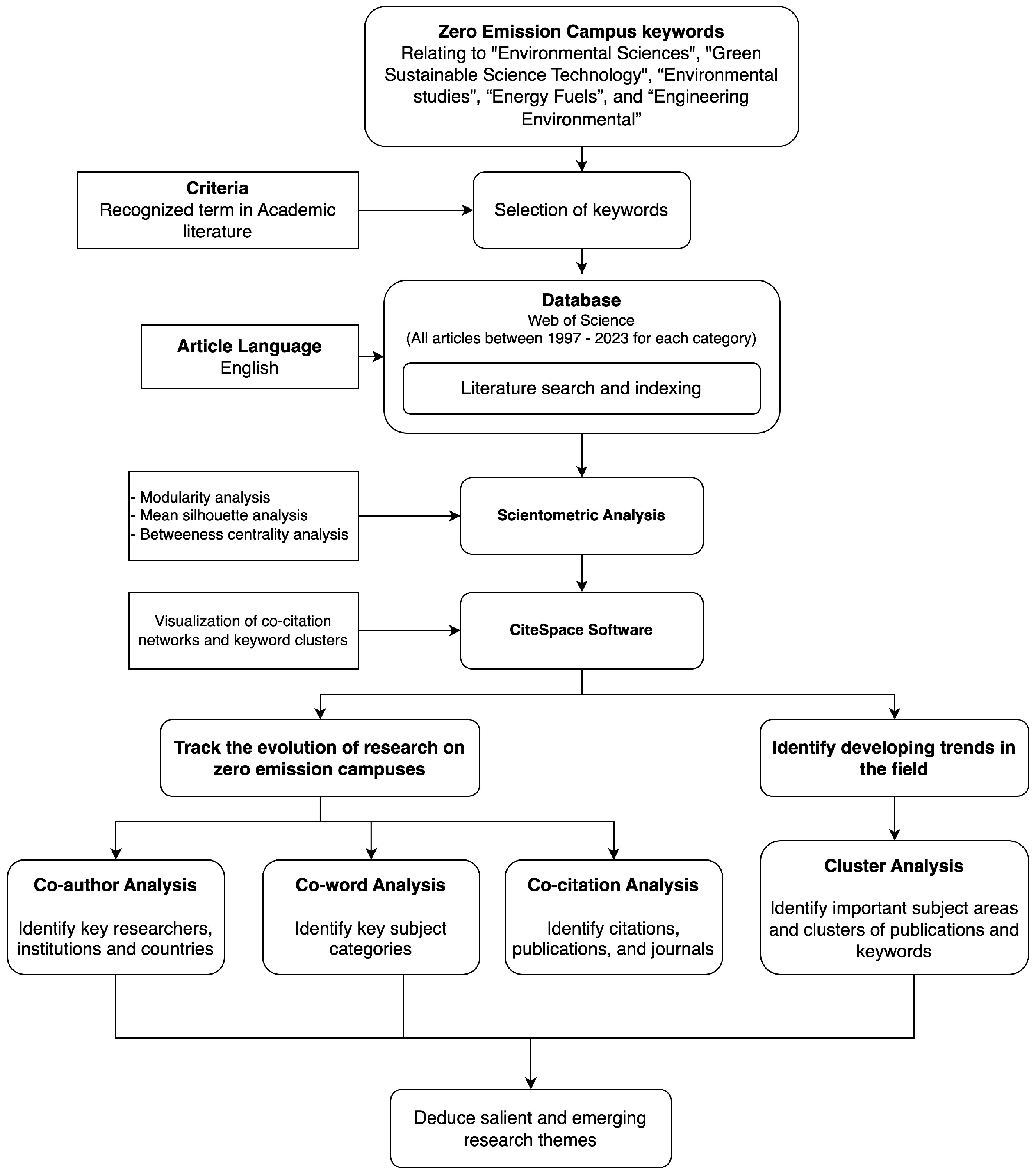
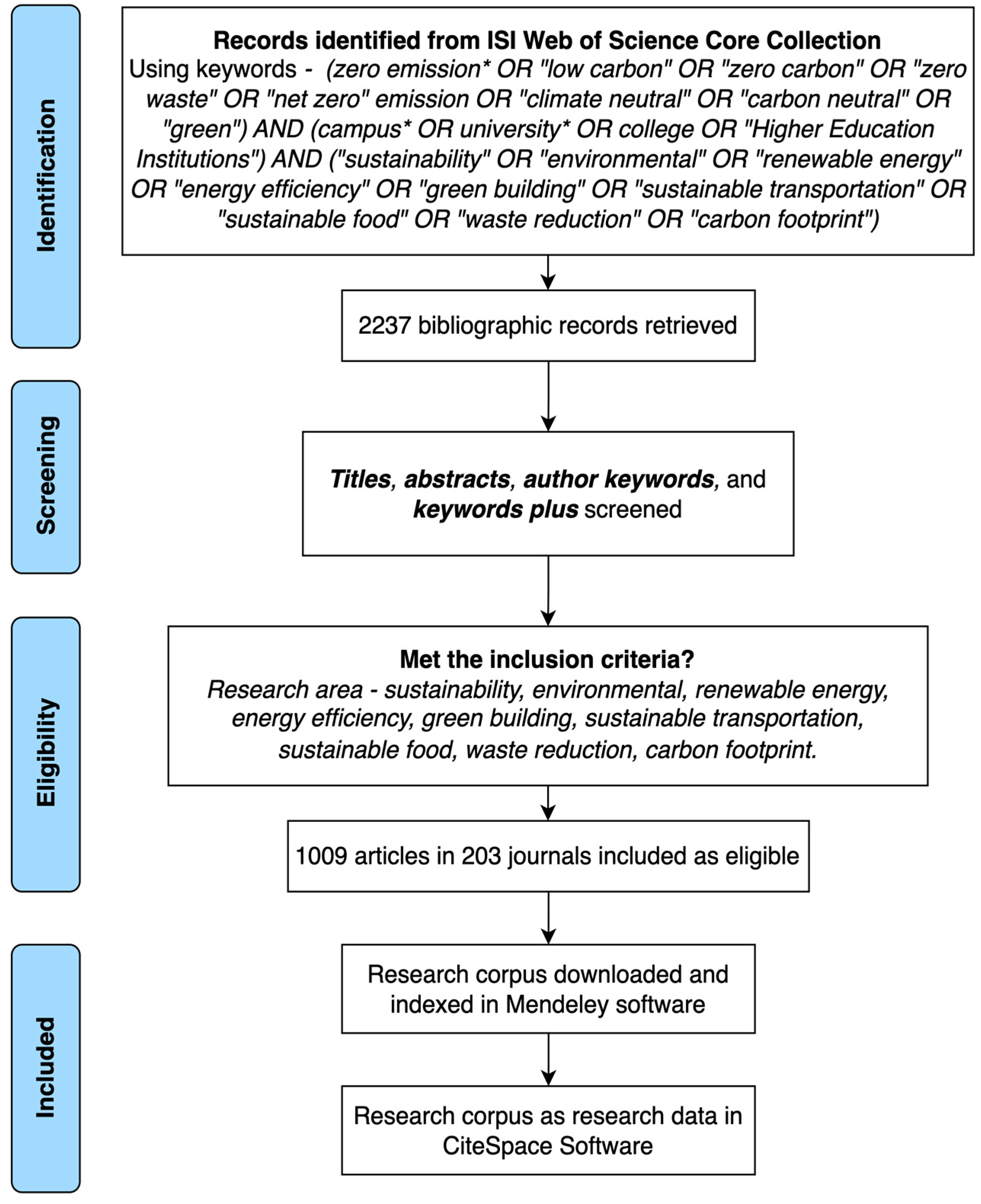
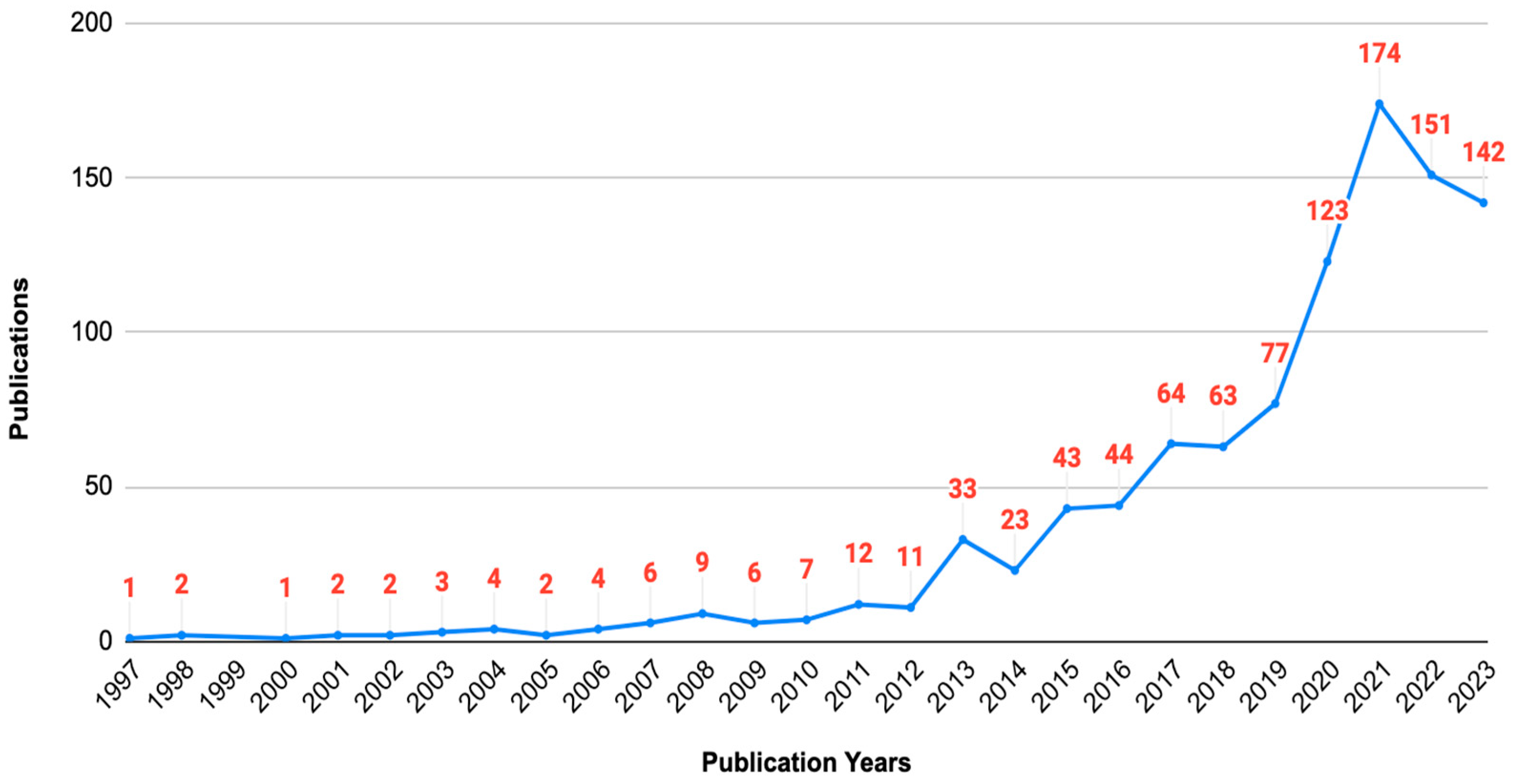
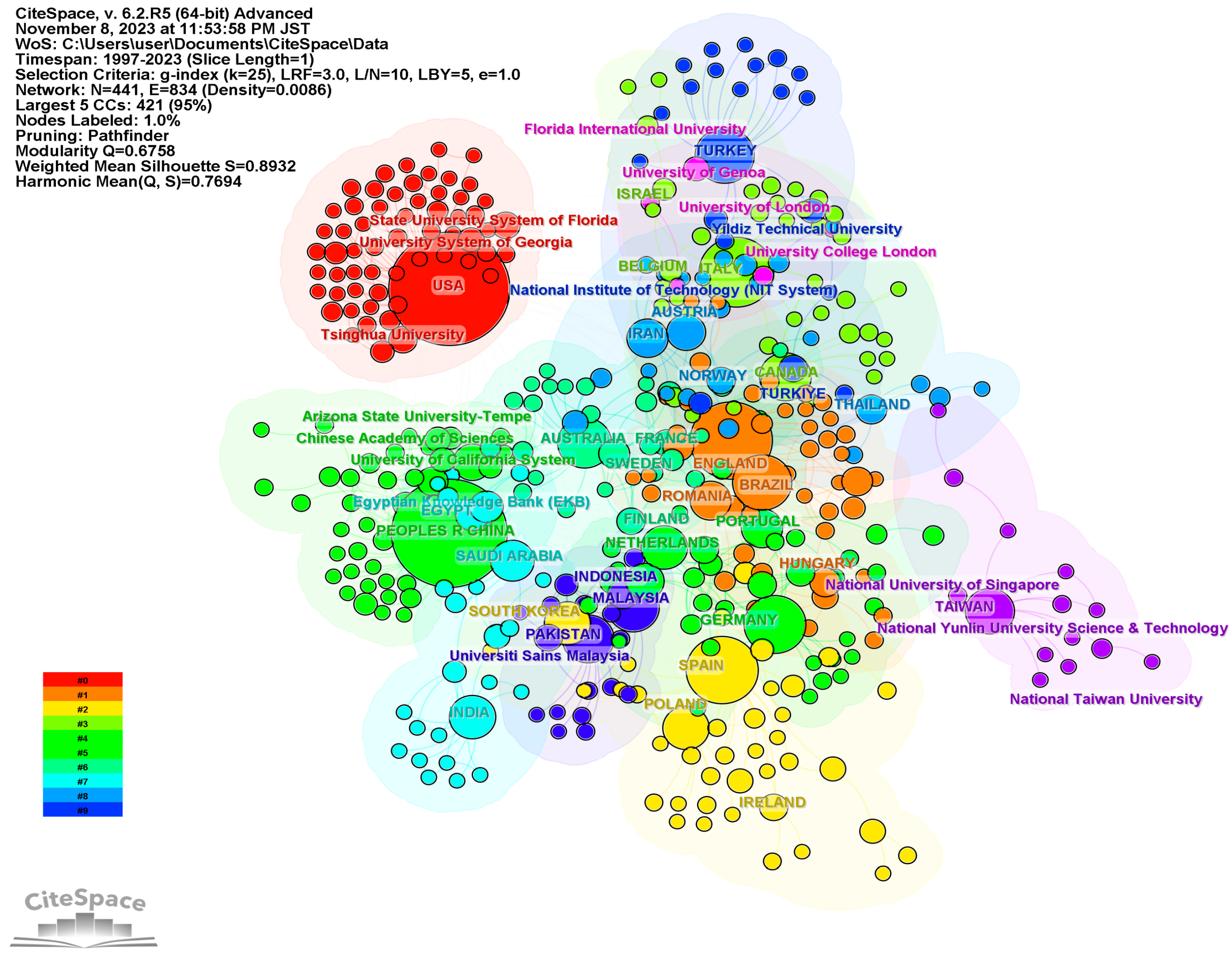
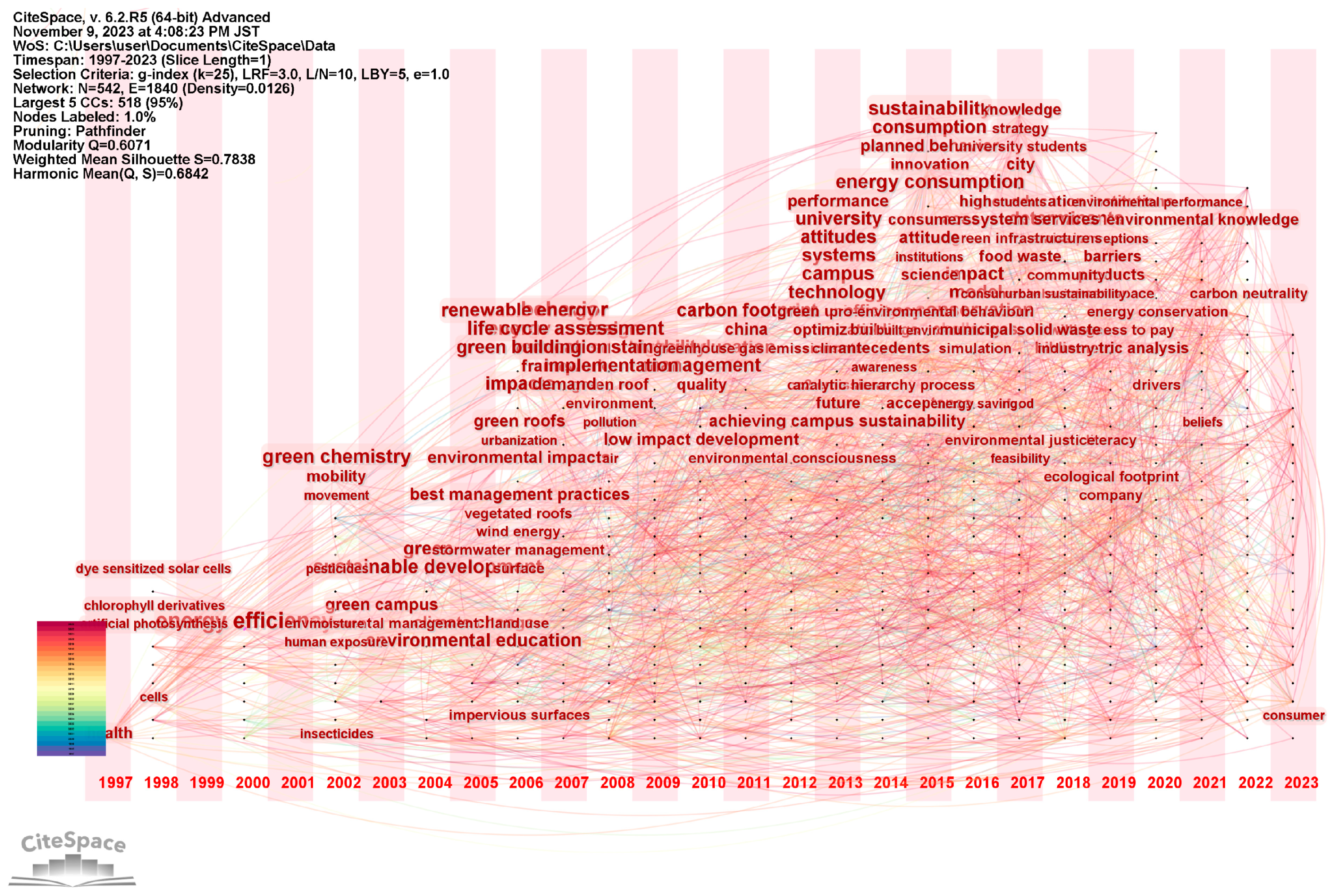


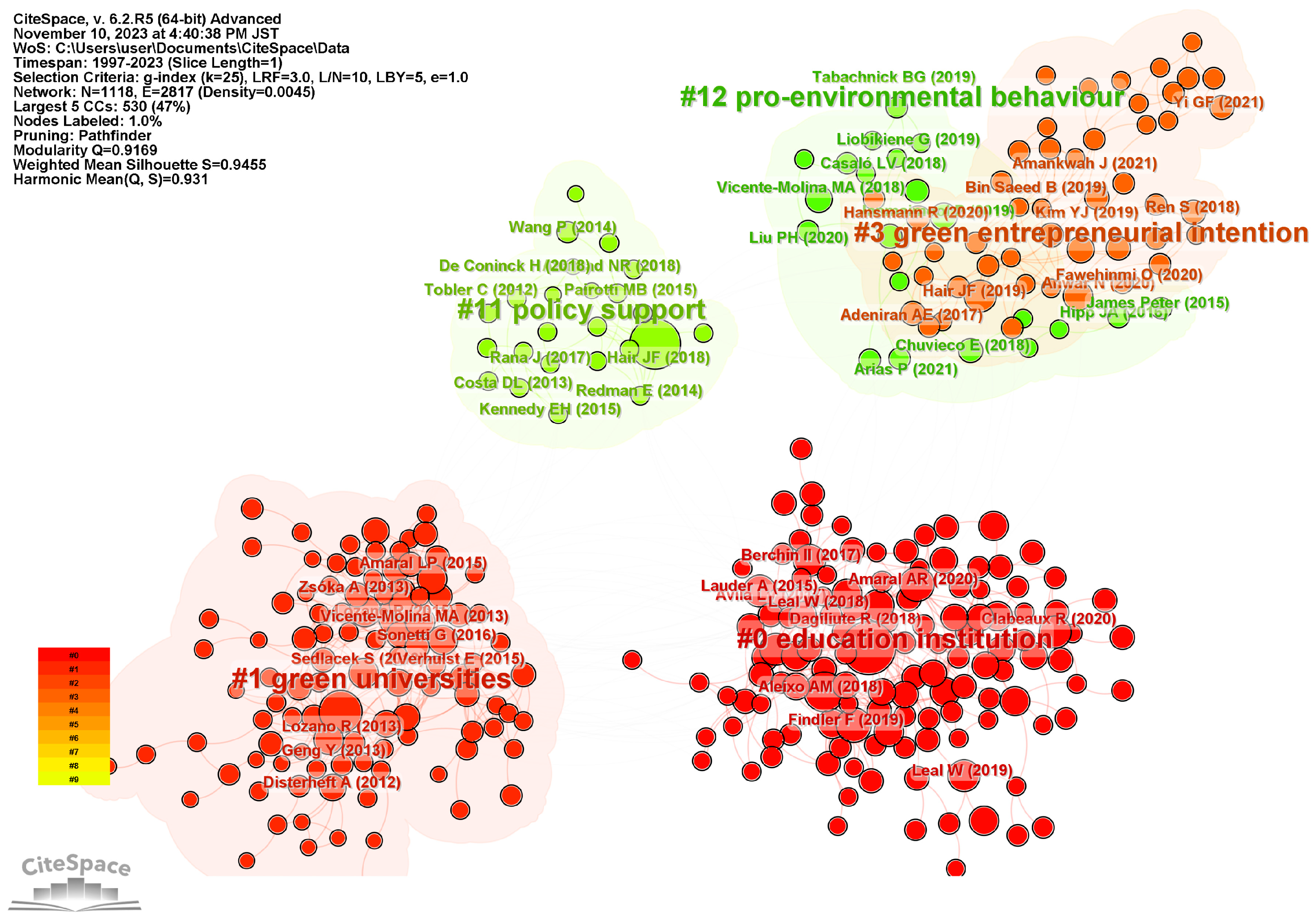
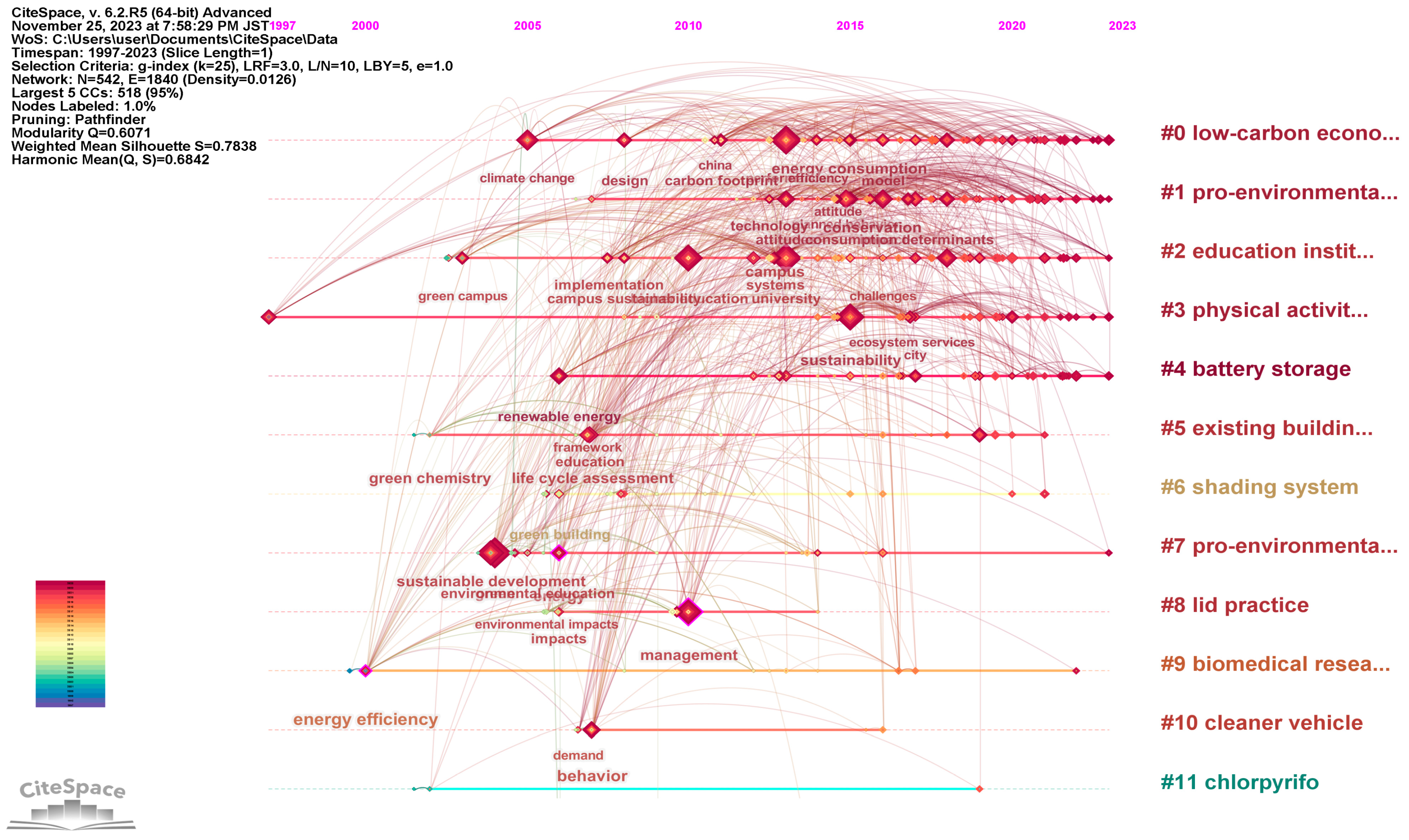
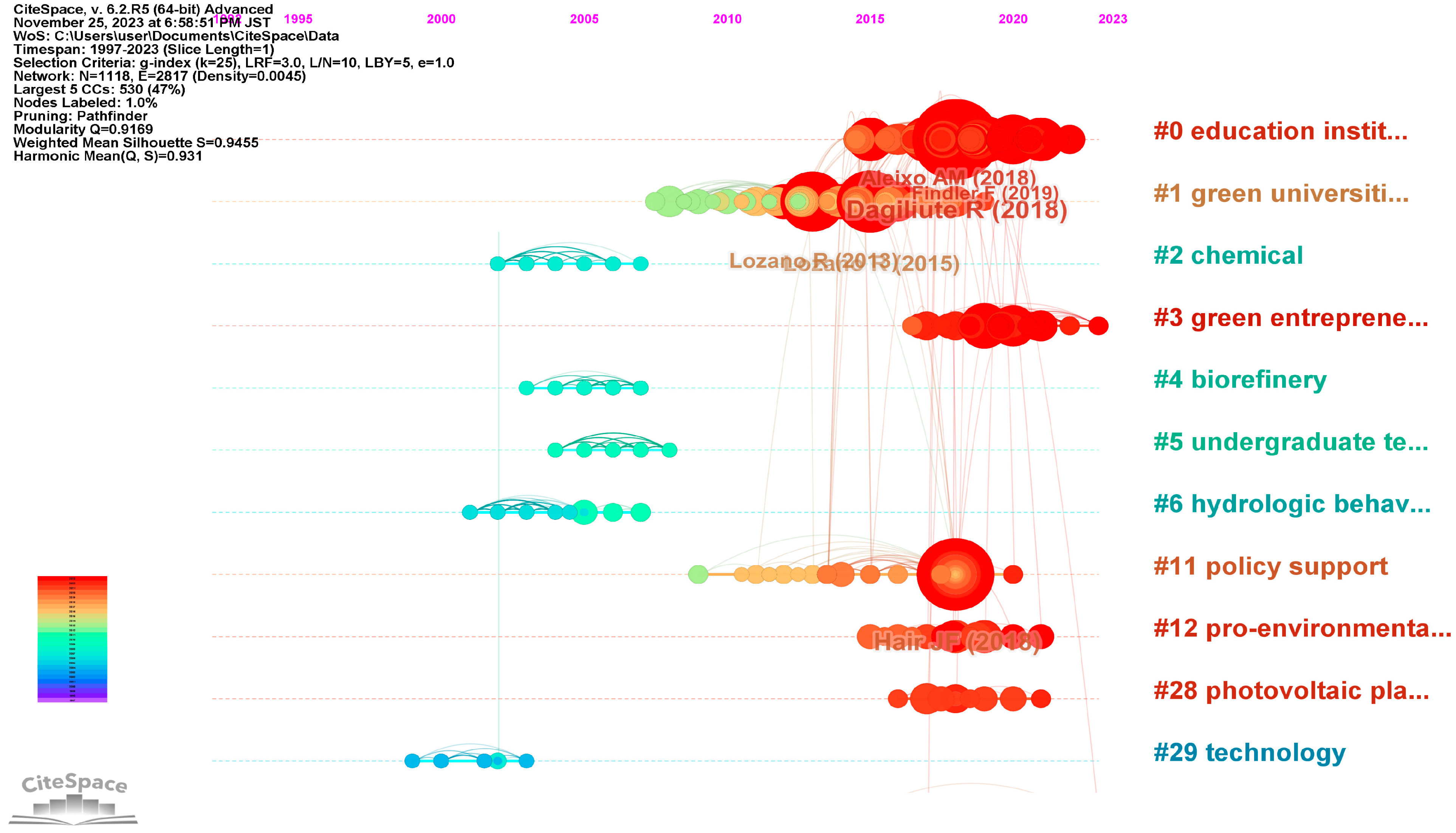
| Authors | Institution | Country | Record Count | H-Index 1 | % of 1009 |
|---|---|---|---|---|---|
| Walter Leal Filho | Manchester Metropolitan University | England | 9 | 45 | 0.892 |
| José Baltazar Andrade Guerra | Universidade do Sul de Santa Catarina | Brasil | 6 | 20 | 0.595 |
| Fabrizio Ascione | University of Naples Federico II | Italy | 4 | 37 | 0.396 |
| Carlos Rogerio Montenegro De Lima | Universidade do Sul de Santa Catarina | Brasil | 4 | 6 | 0.396 |
| Rosa Francesca De Masi | University of Sannio | Italy | 4 | 24 | 0.396 |
| Francisco J. Rey-Martinez | University of Valladolid | Spain | 4 | 8 | 0.396 |
| Thiago Coelho Soares | Universidade do Sul de Santa Catarina | Brasil | 4 | 5 | 0.396 |
| Giuseppe Peter Vanoli | University of Molise | Italy | 4 | 36 | 0.396 |
| Fengqi You | Cornell University | United States | 4 | 67 | 0.396 |
| Ismaila Rimi Abubakar | Imam Abdulrahman Bin Faisal University | Saudi Arabia | 3 | 22 | 0.297 |
| Cecilia Marcelo Aldaz | Autonomous University of Madrid | Spain | 3 | 3 | 0.297 |
| Chia-chien Chang | National Taiwan University | Taiwan | 3 | 11 | 0.297 |
| Ye Chen | Jilin University | China | 3 | 4 | 0.297 |
| Marco Contri | University of Pisa | Italy | 3 | 1 | 0.297 |
| Liziane Araujo Da Silva | Universidade do Sul de Santa Catarina | Brasil | 3 | 1 | 0.297 |
| Country/Regions | Burst Strength | Time Period | Institution | Burst Strength | Time Period |
|---|---|---|---|---|---|
| USA | 12.22 | 2009–2017 | Egyptian Knowledge Bank | 2.82 | 2021–2023 |
| Taiwan | 4.34 | 2014–2019 | Universidade da Coruna | 2.8 | 2020–2021 |
| Thailand | 3.37 | 2019–2021 | University of California Sytem | 2.53 | 2015–2016 |
| Canada | 3.17 | 2008–2012 | State University System of Florida | 2.33 | 2020–2021 |
| Italy | 2.26 | 2016–2019 | Autonomous University of Madrid | 2.14 | 2019–2022 |
| Japan | 2.26 | 2007–2013 | University System of Georgia | 1.87 | 2006–2013 |
| India | 2.14 | 2017–2018 | Southwestern University of Finance and Economics—China | 1.79 | 2021–2023 |
| Israel | 1.87 | 2015–2020 | University of California Berkeley | 1.7 | 2015–2019 |
| England | 1.83 | 2014–2016 | Lappeenranta-Lahti University of Technology | 1.64 | 2016–2018 |
| Indonesia | 1.76 | 2020–2021 | Lund University | 1.62 | 2005–2013 |
| Keywords | Strength | Time Period |
|---|---|---|
| Green building | 5.44 | 2006–2016 |
| Energy efficiency | 4.85 | 2008–2015 |
| Tool | 4.45 | 2020–2021 |
| Behaviour | 3.88 | 2015–2019 |
| Pro-environmental behaviour | 3.65 | 2019–2021 |
| Green space | 3.65 | 2019–2021 |
| Conservation | 3.58 | 2016–2018 |
| Climate change | 3.55 | 2018–2019 |
| Intention | 3.23 | 2020–2021 |
| Theory of planned behaviour | 3.23 | 2020–2021 |
| Urban | 3.18 | 2021–2023 |
| Environments | 3.01 | 2019–2020 |
| Green buildings | 2.84 | 2021–2023 |
| Efficiency | 2.83 | 2014–2018 |
| Feedback | 2.82 | 2017–2018 |
| Publication Titles | Host Country | Impact Factor 1 | H-Index | Publisher | Record Count |
|---|---|---|---|---|---|
| Sustainability | Switzerland | 3.889 | 136 | MDPI | 210 |
| International Journal of Sustainability in Higher Education | United Kingdom | 4.12 | 72 | Emerald Group Publishing Ltd. | 104 |
| Journal of Cleaner Production | United Kingdom | 11.07 | 268 | Elsevier Ltd. | 94 |
| Energies | Switzerland | 2.841 | 132 | MDPI | 32 |
| International Journal of Environmental Research and Public Health | Switzerland | 4.598 | 167 | MDPI | 23 |
| Energy and Buildings | Netherlands | 9.238 | 214 | Elsevier | 20 |
| Environmental Science and Pollution Research | Germany | 3.986 | 154 | Springer Nature | 19 |
| Applied Energy | United Kingdom | 11.745 | 264 | Elsevier | 18 |
| Building and Environment | United Kingdom | 8.003 | 189 | Elsevier | 17 |
| Cited Journals | Burst Strength | Time Period |
|---|---|---|
| Sustainability | 13.78 | 2011–2019 |
| Energy Policy | 12.72 | 2013–2018 |
| Energy and Buildings | 11.57 | 2011–2018 |
| International Journal of Sustainability in Higher Education | 9.05 | 2011–2016 |
| Journal of Social Issues | 7.74 | 2013–2018 |
| Atmospheric Environment | 7.23 | 2013–2019 |
| Journal of Environmental Education | 5.91 | 2013–2018 |
| Solar Energy | 5.78 | 2013–2017 |
| Health Place | 5.64 | 2021–2021 |
| Journal of Environment International | 5.55 | 2020–2023 |
| Journal of Marketing | 5.45 | 2015–2017 |
| Environment | 5.42 | 2014–2020 |
| Environmental Research | 5.2 | 2021–2023 |
| Ecological Economics | 5.11 | 2016–2018 |
| Cluster ID | Size | Silhouette | Cluster Label (LLR) | Alternative Label | Average Year |
|---|---|---|---|---|---|
| 0 | 53 | 0.646 | low-carbon economy (371.73, 1.0 × 10−4) | education institution; sustainable economy | 2016 |
| 2 | 51 | 0.712 | education institution (718.55, 1.0 × 10−4) | education institution; sustainanle economy | 2016 |
| 1 | 49 | 0.613 | pro-environmental behavior (629.27, 1.0 × 10−4) | university student; sustainable economy | 2017 |
| 3 | 34 | 0.747 | neighborhood greenness (430.75, 1.0 × 10−4) | neighborhood greennesss; sustainable economy | 2017 |
| 4 | 30 | 0.715 | systematic review (276.6, 1.0 × 10−4) | case study; energy policy target | 2018 |
| 5 | 18 | 0.909 | using photovoice (182.86, 1.0 × 10−4) | life cycle assessment; polygeneration system | 2010 |
| 6 | 18 | 0.853 | soil surface (110.93, 1.0 × 10−4) | case study; early life exposure | 2010 |
| 7 | 18 | 0.87 | pharmaceutical compound (197.64, 1.0 × 10−4) | sustainable development; sustainable economy | 2008 |
| 9 | 11 | 0.865 | environmental practice (127.36, 1.0 × 10−4) | biomedical research facilities; renewable building energy supply-a case | 2010 |
| 8 | 10 | 0.981 | hydrologic behaviour (144.73, 1.0 × 10−4) | university campus; sustainable economy | 2008 |
| Cluster ID | Size | Silhouette | Label (LLR) | Alternative Label | Average Year |
|---|---|---|---|---|---|
| 0 | 127 | 0.875 | education institution (107.83, 1.0 × 10−4) | education institution; biorefinery | 2018 |
| 1 | 105 | 0.924 | green universities (88.39, 1.0 × 10−4) | case study; environmental sustainability awareness | 2013 |
| 2 | 57 | 1 | chemical (13.8, 1.0× 10−4) | new trends for design towards sustainability chemical engineering, green engineering; education institution | 2003 |
| 3 | 48 | 0.932 | green entrepreneurial intention (74.25, 1.0 × 10−4) | environmental performance; psychological resource | 2019 |
| 4 | 47 | 1 | biorefinery (13.8, 1.0 × 10−4) | biorefinery: conversion of woody biomass to chemicals, energy and materials; education institution | 2005 |
| 5 | 46 | 1 | undergraduate teaching laboratory (14.98, 1.0 × 10−4) | a review of aqueous organic reactions for the undergraduate teaching laboratory; education institution | 2005 |
| 6 | 29 | 1 | hydrologic behavior (16.03, 1.0 × 10−4) | hydrologic behaviour of vegetated roofs; education institution | 2003 |
| 11 | 24 | 0.964 | policy support (107.51, 1.0 × 10−4) | policy support; green innovation investment | 2014 |
| 12 | 21 | 0.964 | pro-environmental behaviour (139.26, 0.005) | pro-environmental behavior: zero-waste campus framework | 2018 |
| 28 | 8 | 0.999 | photovoltaic plant (39.01, 1.0 × 10−4) | economic analysis; education institution | 2018 |
Disclaimer/Publisher’s Note: The statements, opinions and data contained in all publications are solely those of the individual author(s) and contributor(s) and not of MDPI and/or the editor(s). MDPI and/or the editor(s) disclaim responsibility for any injury to people or property resulting from any ideas, methods, instructions or products referred to in the content. |
© 2023 by the authors. Licensee MDPI, Basel, Switzerland. This article is an open access article distributed under the terms and conditions of the Creative Commons Attribution (CC BY) license (https://creativecommons.org/licenses/by/4.0/).
Share and Cite
Longfor, N.R.; Hu, J.; Li, Y.; Qian, X.; Zhou, W. Scientometric Trends and Knowledge Gaps of Zero-Emission Campuses. Sustainability 2023, 15, 16384. https://doi.org/10.3390/su152316384
Longfor NR, Hu J, Li Y, Qian X, Zhou W. Scientometric Trends and Knowledge Gaps of Zero-Emission Campuses. Sustainability. 2023; 15(23):16384. https://doi.org/10.3390/su152316384
Chicago/Turabian StyleLongfor, Nkweauseh Reginald, Jiarong Hu, You Li, Xuepeng Qian, and Weisheng Zhou. 2023. "Scientometric Trends and Knowledge Gaps of Zero-Emission Campuses" Sustainability 15, no. 23: 16384. https://doi.org/10.3390/su152316384
APA StyleLongfor, N. R., Hu, J., Li, Y., Qian, X., & Zhou, W. (2023). Scientometric Trends and Knowledge Gaps of Zero-Emission Campuses. Sustainability, 15(23), 16384. https://doi.org/10.3390/su152316384







